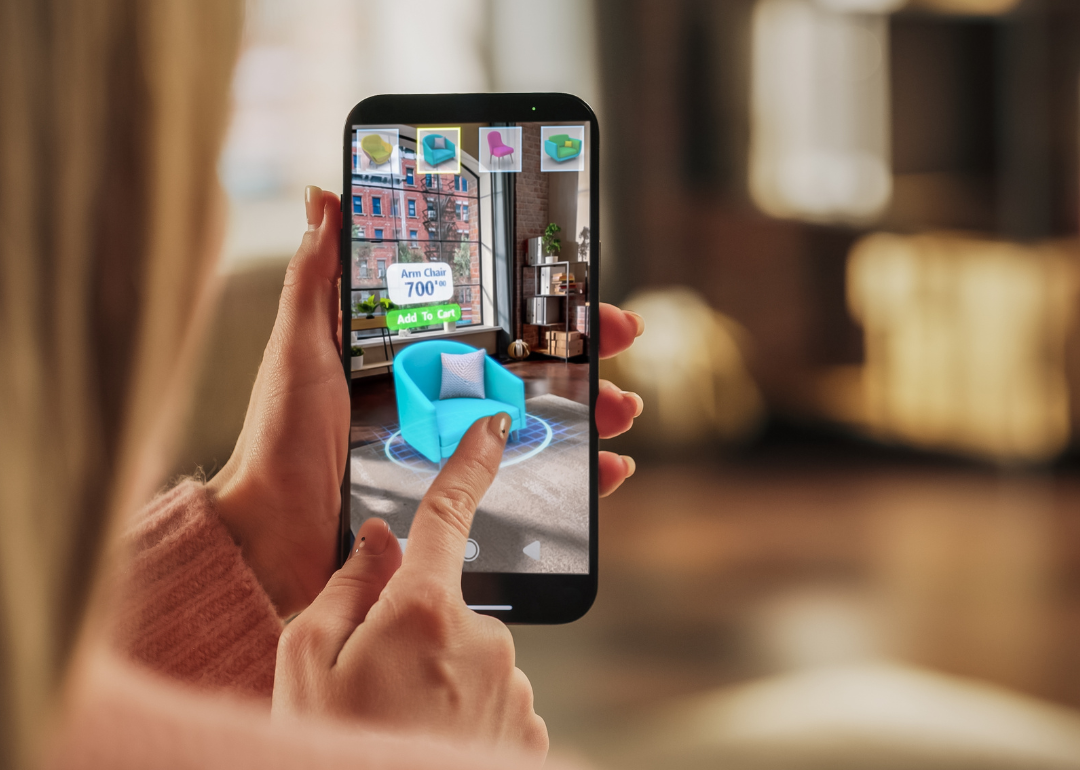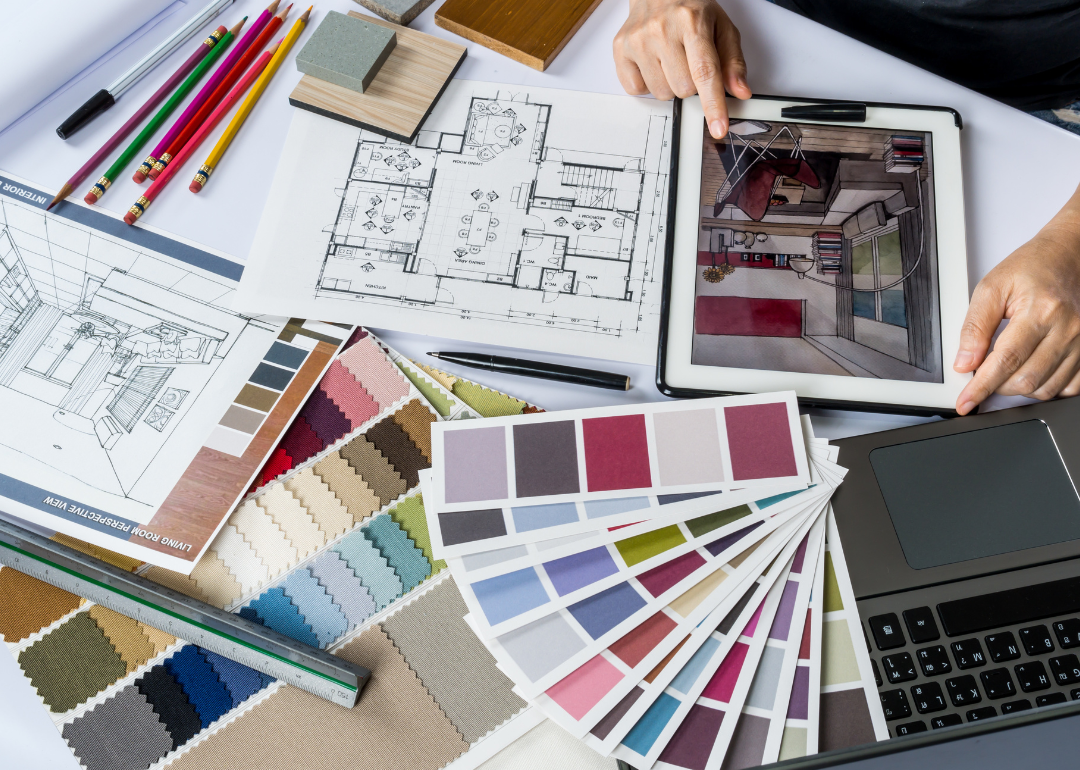5 ways interior designers are using AI

Andy Dean Photography // Shutterstock
5 ways interior designers are using AI
Hands holding tablet in room.
As artificial intelligence technology (or AI, for short) evolves, society must grapple with how it should and shouldn’t be used in everyday life. These questions also apply to several creative industries—notably interior design, where automated software can help designers perform numerous key tasks, from sourcing materials to generating immersive floor plans.
No matter its wide range of uses, it’s important to remember AI software should not aim to replace the humans who bring vital artistry and craftsmanship to interior design projects—no technology can replicate that. AI technology should merely aid creative workers in their endeavors.
In a February 2023 Elle Decor interview, computational designer and Harvard professor Jose Luis García del Castillo y López compared designers’ use of AI-generated design to that of coffee-table books and Pinterest boards. “We are going to act as curators of the information that we will generate ourselves synthetically,” he said. “The value here is not anymore about the creation; it’s about the curation.”
What does this actually look like in practice? Lazzoni Modern Furniture researched and unpacked five ways interior designers use AI software in their work and which programs could have a major impact on the industry moving forward.
![]()

Gorodenkoff // Shutterstock
Personalized design recommendations
Woman using app to select furnishings.
Gone are the days when designers had to search endless websites and storefronts to find ideal products to fit their clients’ aesthetics. AI can offer all sorts of tailored recommendations, from furniture and color schemes to DIY home project materials.
In 2022, for instance, IKEA launched its Kreativ app so “customers can easily create editable and lifelike 3D replicas of their own spaces, which they can edit and design with IKEA products.” A similar tool, Homestyler’s AI Designer, allows users to upload an image of their room and choose a design style. AI technology then generates personalized design options based on those two choices.

Stock-Asso // Shutterstock
Predicting trends
Interiors designers checking samples.
As the Portuguese luxury design studio Hommés pointed out, AI can help designers predict popular style and product trends by analyzing consumer behavior and patterns across the internet.
WGSN, a trend-forecasting platform, uses AI-driven analytics to anticipate interior design trends, among others. The company already has access to a wealth of trend data, including over 100,000 social media posts—which are tagged and classified using image recognition—and data from over 10,000 brands that includes descriptions, prices, and promotions. The company simply added a layer of AI technology into the mix, so its data scientists can work through large amounts of data to form trend predictions.

Mangostar // Shutterstock
Immersive mock-ups
Designer presenting to clients with VR.
Virtual reality and augmented reality software powered by AI algorithms—think Planner 5D or RoomSketcher—allow designers to turn traditional 2D floor plans into immersive 3D models to give clients a better sense of what their space will look like.
Creating these floor plans and designs can also be done more seamlessly using generative, text-based AI. “[With generative AI], you have an idea, you start typing some words, and boom, you get the final renderings,” London-based architect Arthur Mamou-Mani told Elle Decor. “The immediacy of the results versus the idea has never been that quick, which means you can iterate extremely fast.”
Jessica Humphris, the interior designer and 3D artist behind the YouTube channel Redone, uses Midjourney to create interior design renderings using text. She inputs a type of design style or feeling she wants to evoke into Midjourney, which generates an image that can be used as inspiration for her designs. In an August 2022 video, Humphris described the images Midjourney generated as “a bit rudimentary” and “not like a refined design” but acknowledged it’s a new tool that should only get better with time.

Naphat_Jorjee // Shutterstock
Space planning
Person reviewing plans and materials.
When used well, AI software can help designers create multipurpose, efficiently designed spaces by doing things like analyzing dimensions and placements of doors and windows in a specific space.
Boston-based space planning company Lambent, for example, uses AI-based tools to study how many people enter a space and at which location at any given time. By finding those patterns in massive amounts of data, the tool can anticipate how full a space will be at given times, how workspaces can be budgeted to ensure there is enough for how many people are anticipated to use it, and how much occupancy can change over time.

Dragon Images // Shutterstock
Sustainability planning
Person looking at interior concepts.
Sustainability is one of the biggest challenges in interior design, and AI technology’s ability to process extensive data can help designers make design decisions and quickly go through multiple versions with less waste. As Lisa Mcleod, head of design at the London-based architecture and planning company AW Spaces, noted in July 2023: “The dematerialisation of AI-generated images means that the trial and error process of design is not only expedited but also creates less waste when going through the process of redesign.”
What’s more, AI could also help recommend sustainable materials. “AI can actually take certain very complex problems in the world and recast them,” Autodesk Vice President of Research Mike Haley told MIT Technology Review in January 2022, explaining that these “complex problems” include sustainability.
“You really want to be able to look at the entire lifecycle of producing something and ask yourself, ‘How can I produce this by using the least amount of energy throughout?'” Haley added. “We are not going to have a sustainable society until we learn to build products … that survive the long-term.”
Story editing by Carren Jao. Copy editing by Paris Close.
This story originally appeared on Lazzoni Modern Furniture and was produced and
distributed in partnership with Stacker Studio.